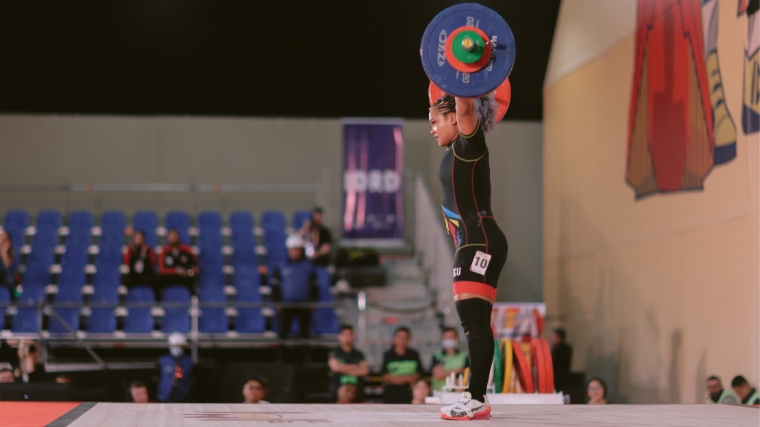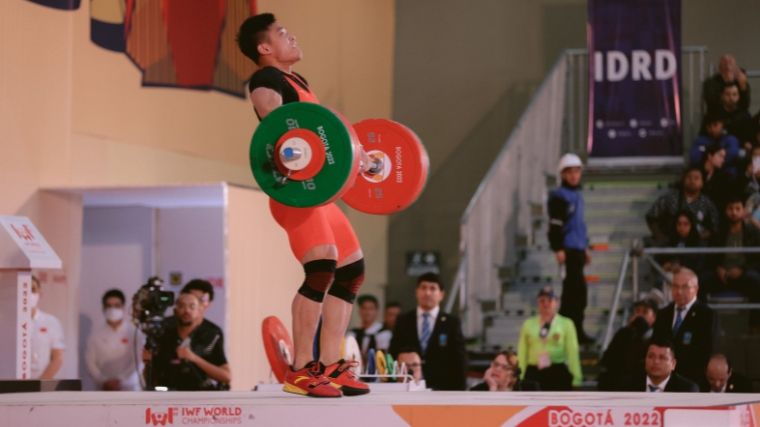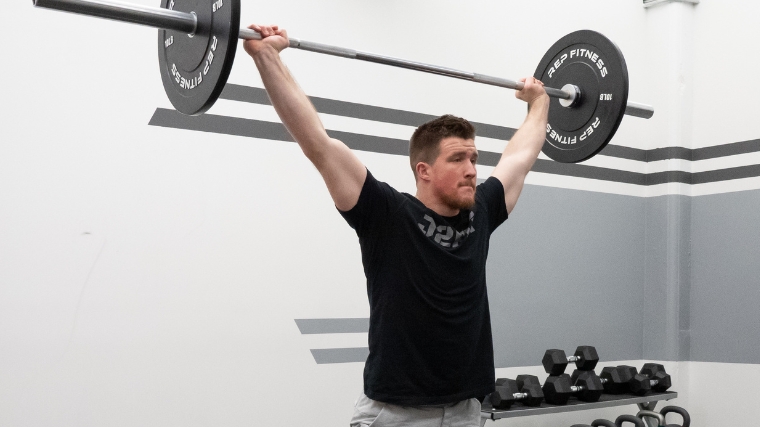In many ways, the sport of weightlifting is like skipping rocks: If you aimlessly chuck a rock out into the water, it’ll hit with a distinct plunk and sink right to the bottom. But if you get low and sling it correctly, that same rock will skim and bounce across the surface as though it weighed nothing at all.
If you want to make an ultra-heavy barbell feel utterly weightless, timing and contact are everything. Brute strength will get you somewhere, sure, but finesse can really help you go the distance.

To level up your performance on the weightlifting platform, you need to understand the differences between hip and thigh contact: What they are, why it matters, and how to do it properly. Here’s how to skip a rock.
- What Is Contact in Weightlifting?
- The Importance of Grip Width
- Hip vs. Thigh Contact in Weightlifting
- Contact vs. No-Contact in Weightlifting
- Best Drills for Hip & Thigh Contact
- Your Takeaways
What Is Contact in Weightlifting?
Weightlifting is — technically, at least — a contact sport. Whether you’re performing the snatch or the clean & jerk, the barbell must come into contact with your legs or hips at some point. This isn’t a standardized technical rule, but it’s something that every weightlifter strives for on the competition platform.
Hip Contact
Hip contact is exactly what it sounds like; a collision between the barbell and the athlete’s hips. When you attempt to vault a loaded barbell from the floor to over your head, your best bet is to get that barbell as close to your hips — the source of most of your power production — as possible before you launch it.

Doing so will improve your leverage and also help you maintain a tight and consistent bar path. Hip contact is utilized almost universally during the snatch, but some athletes can make it work when they clean.
Thigh Contact
On the other hand, thigh contact involves connecting the barbell with your upper leg right before you move into your second pull (deliberately extending your lower body to impart force into the barbell).
[Read More: What It Really Means To Be A Hip Or Knee-Dominant Lifter]
Ultimately, the goal of thigh contact is the same as hip contact. You want to get the bar as close as possible to the joints that create force. In this case, your hips and knees. Most weightlifters use hip contact during the pulling phase of the clean & jerk. If a weightlifter makes thigh contact when they snatch, it is generally considered a technical mistake that the athlete should try to correct.
The Importance of Grip Width
While there are several factors that contribute to whether you make hip or thigh contact — such as the lift you’re performing, the length of your arms relative to your torso, or how you cue yourself when in motion — none matter as much as your grip width.
Think of it this way: During both the snatch and clean, your arms don’t actually do anything other than physically link the barbell to your body. Since both movements are lower-body-dominant, your arms should remain almost entirely relaxed, with little to no bend in your elbows, for the duration of the snatch and clean pulls.
[Read More: The Best Grip Strengtheners On the Market]
Therefore, how wide or narrow you hold the barbell with your hook grip affects where it makes contact on your body. A wide snatch grip should result in the barbell coming neatly into the crease of your hips. To comfortably rack the bar on your shoulders in the front rack position during a clean, you need to use a narrow grip. This generally results in a lower point of contact on your thighs.
This is precisely why hip contact is integral to the snatch as much as thigh contact occurs during the clean & jerk (though there are some exceptions). They aren’t necessarily goals you aim for; each is a consequence of how you have to hold the barbell in the first place.
Hip vs. Thigh Contact in Weightlifting
Where and how you make contact with the barbell during the snatch or clean will strongly impact your potential to make successful lifts. If you’re making contact in the wrong place — or worse, not at all — you’re leaving plenty of kilos on the table.
When to Use Hip Contact
Strive to make crisp and consistent hip contact when you perform the snatch. This is partly due to the criteria of the snatch itself (you must get the bar over your head in one swift motion with a wide grip), but proper hip contact also allows you to utilize the full potential of your lower body.
However, there is an important caveat here: Hip contact is the most mechanically efficient method of imparting upward force into the barbell, and athletes with exceptionally short arms may be able to get the bar up into their hips when they perform the clean.
[Read More: Tips To Pull Under the Bar Faster in Olympic Lifting]
If you can do so without screwing up your pulling technique, go for it. However, if you have to force hip contact in the clean by significantly bending your elbows, you’re doing more harm than good. Early arm bend, as it’s called, may slow down the speed of the bar or prevent you from properly using your legs.
When to Use Thigh Contact
It may be mechanically suboptimal, but almost all weightlifters will find themselves using thigh contact when they perform the clean. This limitation is strictly due to your grip width; holding the barbell too wide will prevent you from establishing a tight front rack position.
Contact vs. No-Contact in Weightlifting
Making contact with the barbell is an integral aspect of sound weightlifting technique. However, in some cases, there’s merit to intentionally avoiding it. No-contact lifts are often used in training sessions to help a weightlifter address certain issues in their technique.
For example, you may have the bad habit of slamming your hips into the barbell when you make contact in the snatch. This tends to cause the barbell to loop outward instead of flying straight up.
[Read More: Everything You Need to Know About How to Increase Strength]
In that case, deliberately performing a no-contact snatch can help you identify what a tight, vertical bar path actually feels like. Perform the snatch as you usually would, but avoid touching the bar to your body at any point.
Preventing bar-body collision reduces your force output and slows down the barbell’s momentum as well. As such, no-contact lifts encourage you to use your upper body more actively than you otherwise would. A no-contact snatch or clean is a viable accessory exercise for an athlete who struggles to use their arms properly during the third pull.
Best Drills for Hip & Thigh Contact
Proper contact in weightlifting is both aggressive and gentle. If you slam your legs or hips into the barbell, you’re imparting force in the wrong direction. You wouldn’t throw something away from you and expect it to fly upward, after all. These drills can help you find the right feeling.
Hip Tap to High Pull
This drill doesn’t have an official name, but you’ll commonly see it included in early weightlifting instruction for both full-time Olympic lifters and functional athletes like CrossFitters. What’s more, you can practice this one at home with a PVC pipe, dowel, broomstick, or empty barbell.
The idea here is simple: Stand upright with your legs and hips slightly bent (what weightlifters call the power position) while holding the bar in your normal snatch grip. Then, deliberately swing the bar a few inches away from your hips and smoothly bring it back in.
Make firm, but not painful, contact with your hips three or four times in succession. Then, on the last rep, as soon as you feel the bar touch your hips, perform either a high pull or a power snatch. This drill helps you synchronize your movement and extend your lower body at the exact moment the bar touches your hips.
Block Snatch (or Clean) Pull
Weightlifting training is renowned for its power output potential. Studies routinely show that Olympic lifters have exceptional force output potential beyond what you can get from standard strength training. (1)(2)
That capability comes from heavy, explosive movements like block pulls. Extending in the snatch or clean teaches you how to synchronize your lower body and make proper bar contact at the same time without worrying about catching the barbell overhead or in the front rack position.
[Read More: Omega 3 Benefits — More Muscle, Better Recovery, and Endurance]
Working from blocks helps refine both of these qualities as well. By starting with the barbell elevated around knee-level, you can prune the irrelevant portions of the snatch or clean pull and zone in on your contact cadence and power production.
Your Takeaways
Proper bar-body contact is integral to success in weightlifting. However, it’s easy to apply too much (or too little) force to your detriment as well. Where and how you make contact depends on several factors.
- Hip contact is the most mechanically efficient form of body contact, since it places the object you’re trying to move very close to the source of your power production. A proper snatch requires good hip contact.
- Thigh contact is less efficient, but is necessary for most weightlifters during the clean.
- Your grip width is the primary factor that determines where you make contact with the barbell.
- The wider your grip, the higher on your legs (or into your hip) you’ll make contact with the bar.
- Strive to make crisp, forceful hip contact. However, it should never be painful or leave bruises on your body.
- Certain instructional drills or accessory exercises can improve the quality of your bar-body contact.
First Contact
Strength isn’t everything. That’s a lesson you’ll learn the hard way both when you try to skip a rock across the water and on the weightlifting platform. To send an impossibly-heavy barbell soaring overhead, you need both brute force and sharp finesse.
Proper bar-body contact gets you there. Hip and thigh contact both have their place in weightlifting; knowing the difference between them will help you lift heavier, move better, and can elevate you to the top of the podium.
References
- Morris, S. J., Oliver, J. L., Pedley, J. S., Haff, G. G., & Lloyd, R. S. (2022). Comparison of Weightlifting, Traditional Resistance Training and Plyometrics on Strength, Power and Speed: A Systematic Review with Meta-Analysis. Sports medicine (Auckland, N.Z.), 52(7), 1533–1554.
- Garhammer J. (1980). Power production by Olympic weightlifters. Medicine and science in sports and exercise, 12(1), 54–60.
Featured Image: William Johnson / BarbellStories
